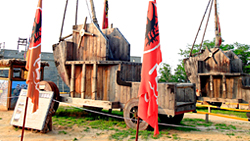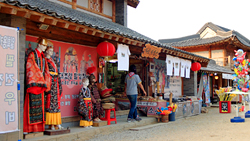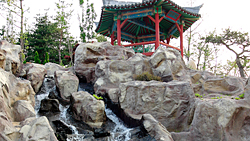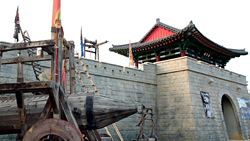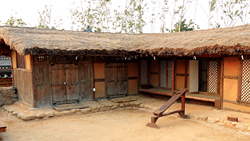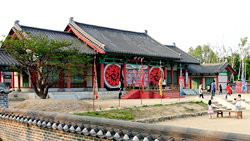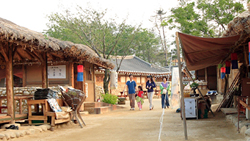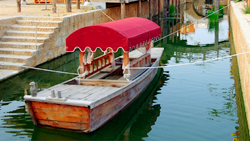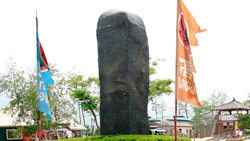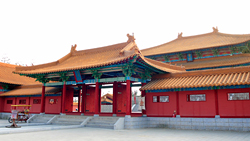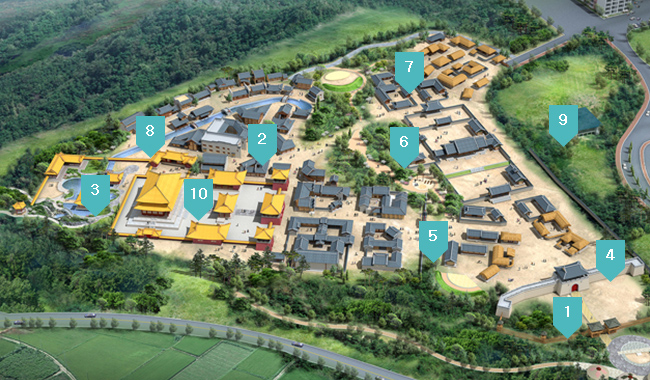
Gongseong is the fight to reclaim the castle and the villages in the fortress. You can feel the grandeur of the generals at this place where enemies have fired rocks through their gun carriages to break through the gate, as arrows rained down from the sky.
The Tang Dynasty historically enjoyed the most flourishing trade with the Western countries. You can feel the busy commercial bustle on the marketstreets. The exotic streets alongside the water channel would reproduce the atmosphere of busy merchants and people living in town. The segments of Dae Jo Yeong caught by General Lee Moon and sent to Chang'an Fortress and of Chang'an people throwing rocks at Dae Jo Yeong were filmed here.
The waterfall perfectly complements the beauty and majesty of the courtyard of Wu Zetian, Empress Consort Wu. Gaze upon the breath-taking columns of water pouring down with white bubbles alongside the rocks. The pavilion on top of the waterfall not only offers a magnificent view of the courtyard and panoramic view of the Imperial Palace, but it is also the best place to take a photo with your family or lover.
This recreation of Goguryeo’s mighty fortress is 75m in length and is made of concrete.
Most of Goguryeo’s fortresses are made of rock and used natural environments because of the frequent wars. This made it difficult for their enemies to easily conquer these mountain fortresses. Imagine the shouts of Goguryeo soldiers who defended the castle by shooting arrows and throwing rocks.
Here, recreations of the homes where ordinary people of Goguryeo had lived. While the palace, government office, temples, and noble houses had tiled roofs, regular houses had thatched roofs. Ordinary people are believed to have used Ondol-type heating systems.
Goguryeo’s superior architectural technology can be confirmed through Chinese’s compliments on its high-quality palaces in its early age and remaining fortress and ancient tombs. It is regretful, however, that the capital city, palaces, and temples were burnt out and destroyed. Goguryeo used a measuring standard cheok (Korean foot) to construct buildings. Goguryeo’s cheok is 34.7 cm – 35.6 cm.
Because of the cheok, Goguryeo people could carry out sophisticated mathematical computations and accurately measure the relation of dynamics of a building and constructed structural architecture through proportional relation. The capital framework used for capitals is an absorbing method of construction that prevents it from wobbling is also a Goguryeo’s architectural characteristic.
The capitals make the buildings look more beautiful and magnificent, and they were also used to build luxurious houses and palaces. In addition, the entasis pillars, which have wider central sections, are the result of the influence of Hellenism.
In this recreation of the markets of Goguryeo, complete with bustling crowds and cries of roosters, you can enjoy the flavors of Gangwon-do from steaming iron pots and pan-fried potato, a shot of local alcohol, and kudzu extract tea. The houses on the northern peninsula were faithfully reproduced: their main feature is that they are elevated from the ground to prevent coldness, and they have less floor for easy access to rooms.
The 130m wide water channel is connected to the courtyard of Wu Zetian, Empress Consort Wu. You can enjoy dugout canoe floating and the sight of leisurely swimming carps.
You can take photos with the water channel in the background on four bridges that connect Tang Dynasty’s marketplace with Goguryeo’s reconstruction site. You can also enjoy the mood of exotic atmosphere of the bygone Tang Dynasty at night as the red lanterns are lit up alongside the water channel.
Jangsu of Goguryeo as a memorial to his deceased father. It is carved out of a single mass of granite with 14-15 cm sized inscription, and it currently has 5mm deep imprints. The four sides of the stele display 44 columns of writing with a total of 1,775 characters in.
This unique monument of Goguryeois Korea’s biggest stele with a width of 1.35m – 2.0m and height of 6.39m.
Tbuildings of the imperial palace are built at an 18m height on a 250 pyeong site. The Tang Dynasty (618-917) was the peak period of the Chinese feudal system that brought social, economic, and cultural development, and this site showcases the Tang Dynasty’s magnificent, precise, orderly, simple, and clear architectural characteristics.
The Chinese overall architecture plan was gradually improved during the Tang Dynasty. Chang'an, the capital city during Tang Dynasty, and Seoan and Nakyang of today all have large-scale palaces, gardens, and government offices, and the architectural structure was even more standardized and practical for that era. Chang'an was the biggest city in the world at the time, had the best regulated plan amongst the Chinese ancient cities.
Daming Palace, the imperial palace of Tang Dynasty in Chang'an, is very vast. The historical site is three times bigger than the Forbidden City. The wooden architecture of the Tang Dynasty realizes the unification of art processing and structure modeling, and the ceilings, pillars, and girders are harmonious and evoke power and beauty. Foguang Temple in Shanxi Province is a shining example of traditional Tang Dynasty architecture. Brick architecture also vastly improved during the Tang Dynasty, and most pagodas adopted brick architecture.
Hanwha Hotels&Resorts Co,.Ltd Registration No : 101-81-30747 Tele Business Declaration No : 01-4402
6~8F, 119 SOGONG-RO, JUNG-GU, SEOUL, KOREA 04525
Copyright@ Hanwha Hotels & Resorts. All Rights Reserved.






